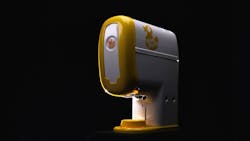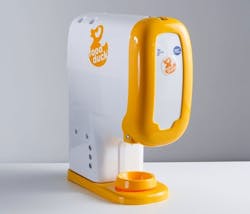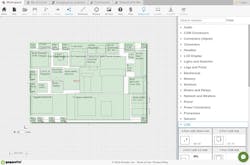Moving from prototype to production can be a challenge especially when a developer’s area of expertise is in the application and the software. One tool that can help is Gumstix’s Geppetto.
FOODDUCK is a Finnish innovation company and a pioneer of automatic dispensing systems for schools, hotels, and restaurants. Its first product, the FOODDUCK Spread Dispenser (Fig. 1), was developed using a stock Gumstix module for design and then customized using Geppetto.
1. The FOODDUCK automatic dispenser solution can provide fats, cream cheese, and spreads in exact proportions.
I talked with Timo Sorsavirta, CEO of FOODDUCK Oy, about how his team used Geppetto for their first three FOODDUCK dispensers. Included in the discussion was Dr. Gordon Kruberg, CEO of Gumstix, who provide insights into Geppetto and the direction of EDA’s evolution.
What product does FOODDUCK produce?
Sorsavirta: The FOODDUCK Spread Dispenser is an environmentally friendly, sustainable, cost-effective, and hygienic alternative to canteens and breadboards.
Timo Sorsavirta, CEO of FOODDUCK Oy.
What are the benefits of FOODDUCK?
Sorsavirta: FOODDUCK is fully automatic and, if necessary, remote-controlled. Its use and sanitation are infinitely easy. The intelligent system also enables accurate data collection to be collected. The device only needs to use the FOODDUCK spreader pack and automatically notifies it about the need for replacement.
The advanced FOODDUCK technology makes it possible to efficiently recycle the packaging and eliminate the loss almost completely. In addition, the exact dose size brings significant savings to the spread and reduces the environmental burden and waste-management costs.
Who are your target customers?
Sorsavirta: The target customers vary depending on the market. For example, in Finland and Sweden, all kids have lunch at school and bread is always a part of the daily meal, and therefore schools are important customers for us. Another important customer group are hotels and restaurants, where the spread dispenser could be an excellent choice to add to their breakfast, lunch, or dinner buffets. Or, for example, quick service restaurants could serve mayonnaise in a spread dispenser.
What was the deciding factor in choosing Geppetto to design and produce your first project?
Sorsavirta: We researched for a good supplier with the best product for our needs, and we found Geppetto. The Geppetto-built Pepper 43C computer-on-module (Fig. 2) featured a capacitive touch display, USB, Ethernet, battery, and clock, which were among our specifications. And to see how it fit our needs, we built a prototype using it. We saw that it met our requirements; its flexibility made it easy to tailor in the Geppetto CAD tool to our specific needs.
2. The FOODDUCK was prototyped using the Gumstix Pepper 43C module and then Geppetto was used to create a custom version.
How do you support the rapidly changing EDA requirements of IoT and IIoT markets?
Kruberg: Pick your estimate, but there will be billions of new IoT devices manufactured over the next decade. There are countless startups writing code for them already. But someone has to design and build them, so they meet the specific format and functional requirements of these new applications.
Dr. Gordon Kruberg, CEO of Gumstix.
Enter Geppetto, our online design tool that lets the software and industrial engineers specify what they need built for their particular application. The FOODDUCK engineers, for example, were able to reduce engineering risk, cost, and to provide the fastest path to market for their products. As FOODDUCK expands across new markets, their engineers will be able to quickly modify and adapt the dispensers with new and changing IoT requirements with a click of a button.
How do you see the future of EDA (electronic design automation) evolving?
Kruberg: The future of EDA involves a wave of automation far exceeding the onscreen drawings by electrical engineers. Next-generation EDA is going to abstract and formalize the design requirements using the basic ideas of object-oriented programming, so high-level requirements can be exported in multiple formats. Our own tool, Geppetto, exports traditional CAD formats, PDFs, and device-tree formats.
Are there other products in development?
Sorsavirta: We continuously develop and design new product models. We are currently expanding our spread dispenser product line so that we can offer the right type of dispenser to be used in different types of restaurants. For example, hotels serve jams or chocolate spreads, and quick-service restaurants serve mayonnaise in it. We see that a wider product line would being of interest also to potential customers in the U.S. market.
What is FOODDUCK’s 5- to 10-year vision?
Sorsavirta: Our target is to grow in the selected markets and become a/the forerunner in this business. We believe that our products tick many boxes in the list of future requirements: circular economy, sustainability, and Internet of Things.
For more, check out “From Prototype to Production with Geppetto: A Foodduck Story.”
About the Author
William G. Wong
Senior Content Director - Electronic Design and Microwaves & RF
I am Editor of Electronic Design focusing on embedded, software, and systems. As Senior Content Director, I also manage Microwaves & RF and I work with a great team of editors to provide engineers, programmers, developers and technical managers with interesting and useful articles and videos on a regular basis. Check out our free newsletters to see the latest content.
You can send press releases for new products for possible coverage on the website. I am also interested in receiving contributed articles for publishing on our website. Use our template and send to me along with a signed release form.
Check out my blog, AltEmbedded on Electronic Design, as well as his latest articles on this site that are listed below.
You can visit my social media via these links:
- AltEmbedded on Electronic Design
- Bill Wong on Facebook
- @AltEmbedded on Twitter
- Bill Wong on LinkedIn
I earned a Bachelor of Electrical Engineering at the Georgia Institute of Technology and a Masters in Computer Science from Rutgers University. I still do a bit of programming using everything from C and C++ to Rust and Ada/SPARK. I do a bit of PHP programming for Drupal websites. I have posted a few Drupal modules.
I still get a hand on software and electronic hardware. Some of this can be found on our Kit Close-Up video series. You can also see me on many of our TechXchange Talk videos. I am interested in a range of projects from robotics to artificial intelligence.






